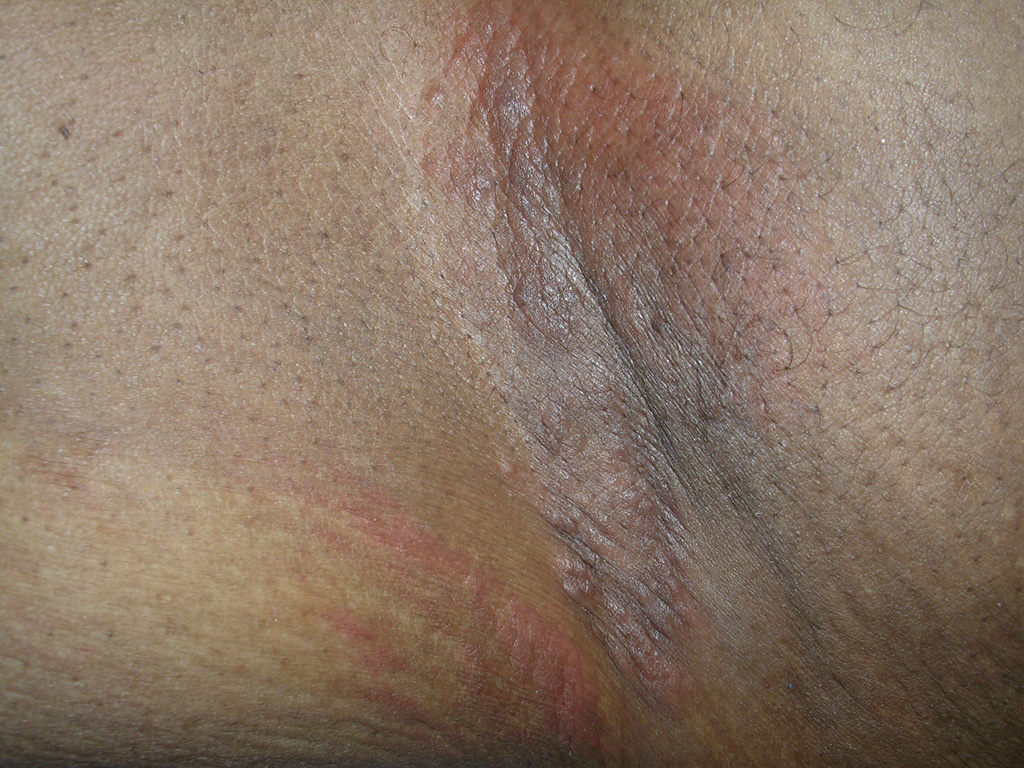The use of tumor necrosis factor-alpha (TNF-alpha) inhibitors in the management of chronic inflammatory conditions is increasing in dermatology and rheumatology practices. We report a case of an unusual drug eruption in flexural areas occurring in a patient treated with adalimumab for rheumatoid arthritis.
A fifty-one-year old woman with a fourteen-month history of seropositive rheumatoid arthritis presented for evaluation of an erythematous, pruritic rash in flexural areas. The eruption began four months after initiating adalimumab, a TNF-alpha inhibitor for her rheumatoid arthritis. Adalimumab was temporarily discontinued for four weeks with improvement of the cutaneous eruption; however, the eruption reappeared three weeks after the medication was reinitiated and had an identical appearance. Drug regimen review revealed no other recent medication adjustments. The patient did not have a personal or family history of psoriasis. Concurrent medications included aspirin, hydrochlorothiazide, hydroxychloroquine, and metformin. Rheumatoid factor, ESR-Westergreen, and C-reactive protein levels were elevated at 825 IU/ml, 72mm/h and 3.63 mg/dl, respectively. ESR and C-reactive protein were within normal limits 4 months prior to the eruption.
Physical examination after adalimumab re-challenge revealed red-brown plaques with slightly mammilated/pebbly surface involving both axillae and smaller plaques in the left antecubital fossa and on the left wrist (Fig 1). There were no other skin or nail findings or oral lesions. A punch biopsy showed epidermal hyperplasia and spongiosis, with multiple foci of neutrophils and eosinophils within variably sized intraepidermal pustules (Figs 2a and b). The papillary dermis also contained numerous neutrophils and eosinophils. Sterile biopsy did not grow bacteria, fungi or mycobacteria. The diagnosis of pustular drug eruption was made.
Figure 1.
Red-brown plaques in axillae after rechallenge with adalimumab
Figure 2.
Figure 2a. Routine histology showing acanthotic epidermis with intraepidermal pustule (10x)
Figure 2b. Multiple eosinophils and neutrophils forming an intraepidermal pustule (40x)
Adalimumab, a recombinant human IgG1 monoclonal antibody specific for TNF-alpha, is administered via subcutaneous injection every two weeks for rheumatoid arthritis. The most common side effect is a local injection site reaction. This was seen in 20.9% of patients treated with adalimumab compared to 13.8% treated with placebo in an analysis of four clinical trials.1 Other adalimumab associated skin reactions are rare and include leukocytoclastic vasculitis,2urticaria 3, eczema 4 and a pustular eruption involving the palms and soles.5 There are increased numbers of patients with rheumatological conditions treated with TNF-alpha inhibitor that develop new onset or worsening psoriasis, often with prominent palmoplantar involvement.6+7 5 Table 1 summarizes some cutaneous reactions reported with TNF-alpha inhibitors.
Table I.
| Cutaneous finding | Adalimumab | Infliximab | Etanercept |
|---|---|---|---|
| Injection site/infusion reactions | + | + | + |
| Vasculitis | + | + | + |
| Pustular eruption of palms and soles | + | + | + |
| Pustular eruption of flexural areas | + | − | − |
We favor adalimumab as a causative agent in this pustular eruption due to the temporal nature of the adalimumab initiation and onset of cutaneous lesions. The rapid improvement of the eruption with discontinuation and flare with re-challenge further support our theory. Biopsy showing numerous eosinophils, commonly seen in drug eruptions, is also consistent with an adalimumab-induced pustular eruption.
Cutaneous pustular adverse events have been reported in patients treated with infliximab, adalimumab, and etanercept, . The mechanism for these eruptions is not known, but it has been postulated that TNF-alpha and interferon cross regulation play an important role in pathogenesis. 7. Our case is unusual in that it involves flexural areas and has eosinophilic pustules in the epidermis. In conclusion, physicians monitoring patients utilizing antibody-type TNF-alpha inhibitors must recognize the potential for induction of pustular dermatoses.
Acknowledgments
Funding sources: NIH RO1 AR 049284 (ACG), NIH NIAMS Skin Diseases Research Center P030-AR39750 (KDC, ACG)
Footnotes
Publisher's Disclaimer: This is a PDF file of an unedited manuscript that has been accepted for publication. As a service to our customers we are providing this early version of the manuscript. The manuscript will undergo copyediting, typesetting, and review of the resulting proof before it is published in its final citable form. Please note that during the production process errors may be discovered which could affect the content, and all legal disclaimers that apply to the journal pertain.
Conflict of interest disclosure: None
References
- 1.Scheinfeld N. A comprehensive review and evaluation of the side effects of the tumor necrosis factor alpha blockers etanercept, infliximab, and adalimumab. J Dermatolog Treat. 2004;15:280–294. doi: 10.1080/09546630410017275. [DOI] [PubMed] [Google Scholar]
- 2.Orpin SD, Majmudar VB, Soon C, Azam NA, Salim A. Adalimumab causing vasculitis. Br J Dermatol. 2006;154:998–999. doi: 10.1111/j.1365-2133.2006.07195.x. [DOI] [PubMed] [Google Scholar]
- 3.Nikas SN, Voulgari PV, Drosos AA. Urticaria and angioedema-like skin reactions in patients treated with adalimumab. Clin Rheumatol. 2006;19:1–2. doi: 10.1007/s10067-005-0197-7. [DOI] [PubMed] [Google Scholar]
- 4.Lee HH, Song M, Friedrich M, Gauliard A, Detert J, Rowert J, et al. Cutaneous side-effects in patients with rheumatic diseases during application of tumor necrosis factor-α antagonists. Br J Dermatol. 2007;156:486–491. doi: 10.1111/j.1365-2133.2007.07682.x. [DOI] [PubMed] [Google Scholar]
- 5.Beuthien W, Mellinghoff HU, von Kempis J. Skin reaction to adalimumab. Arthritis Rheum. 2004;50:1690–1692. doi: 10.1002/art.20155. [DOI] [PubMed] [Google Scholar]
- 6.Sfikakis PP, Iliopoulos A, Elezoglou A, Kittas C, Stratigos A. Psoriasis induced by anti-tumor necrosis factor therapy. Arthritis Rheum. 2005;52:2513–2518. doi: 10.1002/art.21233. [DOI] [PubMed] [Google Scholar]
- 7.de Gannes GC, Ghoreishi M, Pope J, Russell A, Bell D, Adams S, et al. Psoriasis and pustular dermatitis triggered by TNF-alpha inhibitors in patients with rheumatologic conditions. Arch Dermatol. 2007;143:223–231. doi: 10.1001/archderm.143.2.223. [DOI] [PubMed] [Google Scholar]




